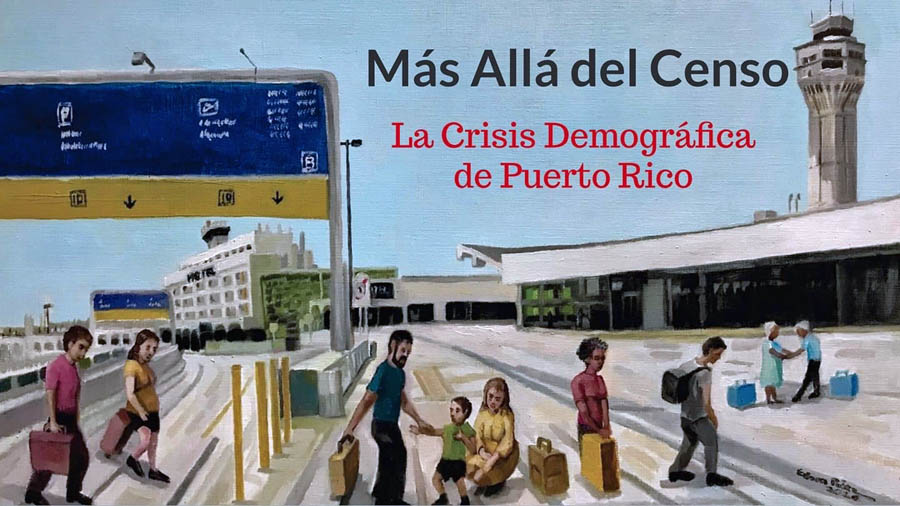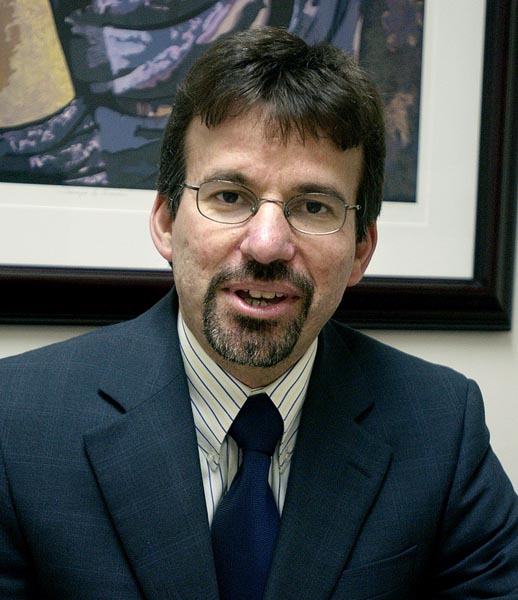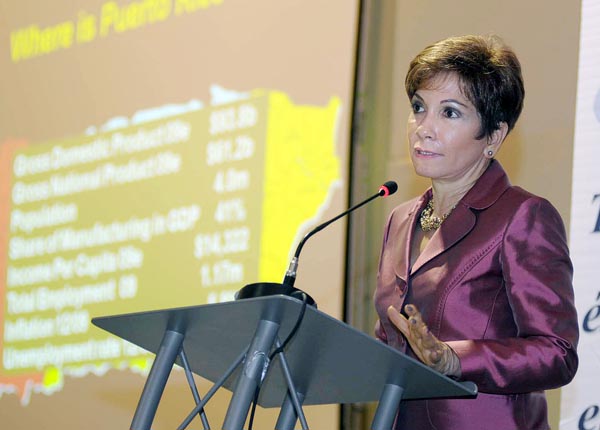Op-Ed: Demography will dictate the failure of PROMESA

Over the last decade, a group of demographers has raised their voices concerning the Puerto Rico’s population decline. Probably the most accessible and comprehensive text on this topic is “Puerto Rico 2000–2010: Más allá del censo” by Raúl Figueroa, Dr. Rosario Rivera-Negrón and Dr. Judith Rodríguez-Figueroa.
Here, I will present some demographic trends regarding Puerto Rico’s demography and will tie it with economic outlooks.
In Figure 1, I present data regarding historical population counts for Puerto Rico between 1910 and 2010. As we can see, there is a deceleration in the population growth for Puerto Rico from 1980 to 2000. However, not a lot of people saw the population decline coming in 2010.

The sour medicine that led to the population decline of 2010, a 2.17% reduction, has not changed. On the contrary, there is a growing consensus that the austerity measures and budget cuts are a lethal dosage for Puerto Rico’s population prospects.
Figure 2 shows that for the 2010–2018 period nothing has changed for Puerto Rico. We are still observing population decline and this decrease seems to be accelerating on a year to year basis (see red line).

Was this change concentrated in certain groups? Indeed. In Figure 3, I present what is in my opinion the most important factoid. The population decline for Puerto Rico is mostly concentrated in younger age groups and those in working ages. The only groups that are growing are those older than 65.

Does it matter if the population decline is concentrated in specific age groups? The answer is YES! We should be concerned that in a period of eight years, Puerto Rico has had a reduction of more than 30% of the two youngest age groups. We’re also concerned about the age groups between 15 to 64 whom we refer to as “Work Age Population.” This is considered one of the most productive sectors of the population and they carry the burden of paying taxes, which maintain the social support services for younger and older age groups.
Social services such as education, health, pensions, and other systems depend on this sector of the population. All of the components of this age group are declining.
In Figure 4, I show the historical data for 1950 to 2010. A review of this data shows that between 1950 and 1980 we had population declines in all age groups. From 1980–2000 onward, the 0–19 years age group experienced the first population decline.

On the other hand, those in the productive ages had a healthy level of growth between 1980–1990 and 1990–2000. However, the “growth” was close to zero in the 2000–2010 period. This deceleration of growth was, mostly due to the outmigration from 2004 and onward. The only groups that grew were those between 65 and 84 and 85 and older.
This has not changed in the current decade (2012–2018, Figure 5).

In the current decade, 2012–2018, Puerto Rico has lost people currently in productive ages (20–64 year-olds) and future members of these age groups (0–19 years old). However, there is mostly growth for those in the older age groups.
Puerto Rico’s dependency rate
One of the indicators that would shed some light about what is happening in Puerto Rico in terms of the sustainability of the economic system is the dependency rate. This indicator tells us how many people — young (0–14 years) and old (65 years and over) — there are in relation to those in working ages (15 to 64 years). Figure 6 shows the dependency rate for Puerto Rico between 1950 and 2010.

As it can be appreciated, the number of people who depend on the working age population has dropped. Today, we have fewer people depending on the working age population than in 1950s. Is this a reason for celebration? No. In Figure 7, I show that this reduction hides the reality. Over the past decades, Puerto Rico lost a significant part of the younger people and has seen an increase in the older ages.

Indeed, there are fewer people in Puerto Rico now than in the 1950s. However, this reduction is due to the decline in the number of children. We also observe population increase in the number of older people in Puerto Rico from of 7 people for every 100 people, to nearly 30. Contrary to this, in the 1950s, we had approximately 82 younger people for every 100 in working ages. This number has reduced to approximately 30 younger people. The trends for 2010–2018 are consistent with what I write here and can be seen in Figure 8.

Due to the trends in births and outmigration, it is highly unlikely that the future is better than the current situation. We’re moving toward an older Puerto Rico, with fewer younger people. The most striking finding is the increase in the older ages component, from 22 to 32 people per 100 working age people, from 2010 to 2018. However, we are moving toward an economy that has a high dependency rate mostly composed by older people (i.e. retirees and those with pensions).
Raúl Figueroa has also published the book “The Elder’s Colony,” which speaks about the decline of Puerto Rico’s population and the changes in the phases of aging.
Is the economy sustainable when the colonial archipelago is emptying? How sustainable is the Adjustment Plan, a result of PROMESA, in light of the changes in age structures?
The economy follows the population
Open any economics book and you will read that the demand of goods and services or the size of the economy are determined (in part) by the number of buyers (total population). Recently, the Bureau of Economic Analysis published the prototype data about population consumption, private investment and exports of goods for Puerto Rico.
These data, produced by a federal agency, point toward a reduction in consumption paired with the population decline. For this period the real salaries also shrunk and prices increased. The reduction in the real salaries and the increase in prices are considered push factors for the population; a push for migration that is.
On the other hand, we see a reduction in private investment for residences. There is some stability in the investments for equipment and intellectual property. Also, we see a reduction in the exports and imports of goods. As one of the pillars of the economy, the pharmaceutical industry showed a reduction of 15.58% in these exports from 2012 to 2017. The reduction in the imports of goods such as food and drinks, medicines and other pharmaceutical products, gas, and others is definitely tied to Puerto Rico’s population decline.
What has this to do with the Adjustment Plan? The adjustment plan is based on the expectation of an increase, or at least stability, in the tax revenues in Puerto Rico. In the Fiscal Plan’s exhibits 3 through 13 we can study the projected sources of tax revenue for the government, which depend the repayment of the public debts.
With a population decline and a contraction in the economy, the outlook is a negative one.
What happens to the economy if the population continues declining?
The Adjustment Plan includes debt repayment goals and the amounts to be paid. The decline in the population and the economy will shape the projected tax revenues to be unrealistic. This will require further adjustments to achieve the payment of the agreed upon amount.
This can only be done by increasing taxes on the population that will remain in the island (more repayment per capita). These adjustments will squeeze the limited budget for the population, which will undoubtedly affect younger people due to the reduction of real salary and the older generation due to the reduction in pensions.
We have already seen an increase in the rates for water services on July 1, and there is an expected increase in the energy costs. These adjustments, mostly increases in the repayment burden, will become the order of the day. Economist Ramón Cao has concluded that neither the residential nor the commercial sectors will not be able to deal with these increases (see previous link). Dr. José Caraballo-Cueto (economist) has also published an Op-Ed in which he indicates that the design of the debt repayment agreement is unsustainable.
The pension cuts will further cause the deceleration of Puerto Rico’s economic activity. Many retirees serve as the head of households and support other generations who are still studying or growing up in Puerto Rico. The reduction in pensions is not only a fatal blow to the quality of life for Puerto Rican retirees, but they will also have consequences for their families. These families and their members could pretty much end up becoming part of the more than 4 million Puerto Ricans living in the United States.
The pieces are in position so that the population and the economy will keep declining. The austerity measures will make the people of Puerto Rico suffer. These austerity measures will further reduce the availability and quality of the health, education and social services provided to them by the government of Puerto Rico.
By all measures, there are no demographic conditions that would make the repayment of the debt a sustainable one.
How do you pay the debt with a shrinking tax base?
Final note
The purpose of this note is to initiate the discussion about the consequences of population decline in light of the austerity measures being imposed in Puerto Rico.

There is no easy solution for the issue of Puerto Rico and its debt. I am not the one holding all the answers. However, the conversations regarding the Fiscal and the Adjustment Plan fail to consider the consequences of the austerity measures, which will serve as push factors.
These will make migration to the mainland U.S. the only option for some.
Is that what they want?










Excellent and relevant info.